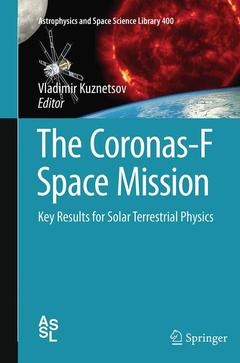Description
The Coronas-F Space Mission, 2014
Key Results for Solar Terrestrial Physics
Astrophysics and Space Science Library Series, Vol. 400
Coordinator: Kuznetsov Vladimir
Language: English
Subjects for The Coronas-F Space Mission:
Publication date: 08-2016
Support: Print on demand
Publication date: 02-2014
483 p. · 15.5x23.5 cm · Hardback
Description
/li>Contents
/li>Biography
/li>Comment
/li>
This volume is the updated and extended translation of the Russian original. It presents the results of observations of solar activity and its effects in the Earth space environment carried out from July 2001 to December 2005 on board the CORONAS-F space mission. The general characteristics of the CORONAS-F scientific payload are provided with a description of the principal experiments. The main results focus on the global oscillations of the Sun (p-modes), solar corona, solar flares, solar cosmic rays, Earth?s radiation belts, and upper atmosphere. The book will be welcomed by students, post-graduates, and scientists working in the field of solar and solar-terrestrial physics.
This English edition is supplemented by sections presenting new results of the SPIRIT and TESIS experiments under the CORONAS solar program, as well as from the SONG experiment onboard the CORONAS-F satellite.
CORONAS–F Project: The study of solar activity and its effects on the Earth.- Brightness fluctuations and global oscillations of the Sun (DIFOS experiment).- Study of Active Phenomena in the Solar Corona in the 8–350 Å Region by Imaging Spectroscopy Methods (SPIRIT Experiment).- Experiment with the SPR-N instrument onboard the CORONAS-F satellite: polarization, temporal and spectral characteristics of the hard X-ray of the solar flares.- Observations of Doppler shifts of X-ray lines in solar flares spectra based on DIOGENESS spectrometer data.- Investigations of physical processes in solar flares plasma on the based on RESIK spectrometer observations.- The study of the cosmic gamma-emission nonstationary fluxes characteristics by the AVS-F apparatus data.- Variability of Extreme Ultraviolet Fluxes at Various Timescales as Measured on Board the CORONAS–F Space Mission (SUFR–SP–K and WUSS–L Experiments).- Scientific Set of Instruments «Solar Cosmic Rays».- Protons Acceleration in Solar Flares: the Results of the Analysis of Gamma-Emission and Neutrons Recorded by the SONG Instrument onboard the CORONAS-F satellite.- Dynamics of the relativistic electrons flux of the Earth outer radiation belt based on the MKL instrument.- Dynamics of the Earth radiation belts during the strong magnetic storms.- Solar protons in the Earth’s magnetosphere according to riometric and satellite data during the magnetic storms of October 2003.- Spectrometer IRIS: Investigation of the Time Structure and Energy Spectra of X-Ray Emission From Solar Flares.- Study of Solar Flares and Gamma-Ray Bursts in the Helicon Experiment.- RPS–1 Experiment.- The impact of solar activity on the Earth upper atmosphere as inferred from the CORONAS–F scientific experiments.- On–board and ground–based complexes for operating the science payload of the CORONAS–F space mission.- CORONAS–F: Infrastructure and organization of theinformation exchange.- Organization of a unified data archive and accessories for processing solar images.
These books may interest you

New Millennium Solar Physics 189.89 €



